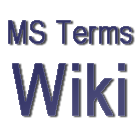Chemical ionization
| IUPAC RECOMMENDATIONS 2013 |
| Chemical ionization |
|---|
Formation of a new ion in the gas phase by the reaction of a neutral with an ion. The process may involve transfer of an electron, a proton, or other charged species between the reactants.
|
| Related Term(s): atmospheric pressure chemical ionization |
| Reference(s):
IUPAC. Analytical Division. Compendium of Analytical Nomenclature (the Orange Book). Definitive Rules, 1979. Compiled by J. Inczédy, T. Lengyel, A. M. Ure. Blackwell Scientific Publications, Oxford (1997). On-line corrected version: http://www.iupac.org /publications/analytical compendium (2000). IUPAC. Compendium of Chemical Terminology, 2nd ed. (the Gold Book). Compiled by A. D. McNaught and A.Wilkinson. Blackwell Scientific Publications, Oxford (1997). XML on-line corrected version: http://goldbook.iupac.org (2006-) created by M. Nic, J. Jirat, B. Kosata; updates compiled by A. Jenkins. PSI-MS: MS:1000071 |
| From Definitions of Terms Relating to Mass Spectrometry (IUPAC Recommendations 2013); DOI: 10.1351/PAC-REC-06-04-06 © IUPAC 2013. |
Orange Book
| ORANGE BOOK DEFINITION
IUPAC. Analytical Division. Compendium of Analytical Nomenclature (the Orange Book). Definitive Rules, 1979 (see also Orange Book 2023) |
| Chemical ionization |
|---|
|
Describes the process whereby new ionized species are formed when gaseous molecules interact with ions. The process may involve transfer of an electron, a proton or other charged species between the reactants. When a positive ion results from chemical ionization the term may be used without qualification. When a negative ion results the term negative ion chemical ionization should be used. Note that this term is not synonymous with chemi-ionization, nor with negative chemical ionization. |
| IUPAC 1997 Orange Book Chapter 12 |
| Index of Orange Book Terms |
Gold Book
| GOLD BOOK DEFINITION
IUPAC. Compendium of Chemical Terminology, 2nd ed. (the Gold Book). Compiled by A. D. McNaught and A.Wilkinson. Blackwell Scientific Publications, Oxford (1997). |
| Chemical ionization |
|---|
|
http://goldbook.iupac.org/C01026.html This concerns the process whereby new ionization species are formed when gaseous molecules interact with ions. The process may involve transfer of an electron, proton or other charged species between the reactants. When a positive ion results from chemical ionization, the term may be used without qualification. When a negative ion is involved, the term negative ion chemical ionization should be used; note that negative ion formation by attachment of a free electron does not fall within this definition. Chemical ionization and chemi-ionization are two terms which should not be used interchangeably. See: electron attachment See also: chemi-ionization Source: PAC, 1991, 63, 1541 (Recommendations for nomenclature and symbolism for mass spectroscopy (including an appendix of terms used in vacuum technology). (Recommendations 1991)) on page 1547 Orange Book, p. 204 PAC, 1990, 62, 2167 (Glossary of atmospheric chemistry terms (Recommendations 1990)) on page 2179 |
| IUPAC Gold Book |
| Index of Gold Book Terms |
| Proteomics Standards Initiative Term |
| Chemical ionization |
|---|
| The formation of a new ion by the reaction of a neutral species with an ion. The process may involve transfer of an electron, a proton or other charged species between the reactants. When a positive ion results from chemical ionization the term may be used without qualification. When a negative ion results the term negative ion chemical ionization should be used. Note that this term is not synonymous with chemi-ionization. [database_cross_reference: PSI:MS] |
| Superclasses: ionization type |
| ID: MS:MS:1000071
Synonym: CI has_exact_synonym: CI |
| Full list of terms | PSI Terms |
External links
|
This term has a corresponding Wikipedia article: Chemical ionization |
